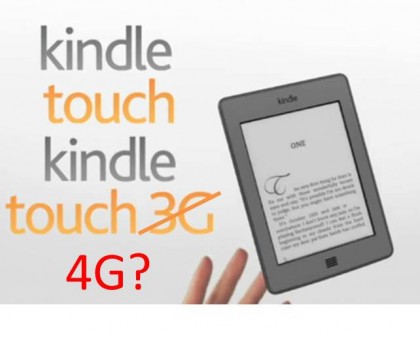
We’re still in the early days of 4G deployments and adoption, and while I’m loving LTE access on my HTC Thunderbolt, the real impact of next-gen mobile broadband won’t be felt for another year or two. When it does hit, we’re likely to see a lot of changes in how mobile devices and applications are developed, managed and priced. According to Tellabs (via GigaOM), carriers are about to lose their data cash cow, and will actually be in the red with mobile data delivery by 2013 if nothing changes. Of course “if nothing changes” is the key clause here. Things will change because no carrier is going to offer a service that can’t ultimately deliver a profit.
One of the more intriguing possibilities for future mobile pricing models is a move toward Amazon’s Whispernet model. The pricier Kindle Touch version is still bundled with free 3G mobile broadband services, but it’s now limited to Kindle store and Wikipedia access. I expect we’ll see a lot more of this – hardware providers bundling mobile broadband with devices, and even app providers bundling access with certain types of applications. There are many mobile activities that can wait for Wi-Fi, but instant gratification can be a powerful draw , and it’s a feature that many are willing to pay for.
For example, the vast majority of my mobile data usage comes from streaming Slacker or NPR. In the future, I could see Slacker bundling mobile data access with my monthly subscription to give me unlimited music streaming. I get that now, but only through a grandfathered unlimited data plan with Verizon, which I don’t expect to last forever. I wouldn’t want to pay an unlimited “tax” on every application, but if there are only one or two that threaten to put me over my monthly limit, I would seriously consider an application-specific broadband fee.
You can see how this would work for video and other services too. Netflix could bundle access with its video service. So could Amazon, either with its Kindle Fire, or with its video streaming service delivered on somebody else’s hardware. When Apple brings its iPhone 5 to market with 4G, it could bundle access to iTunes. Or it could bake mobile broadband access into its new Nano for fitness applications. The possibilities are limitless.
If delivered well, the Whispernet model is something people would pay for. And in a world of 4G speeds, it would make mobile broadband feel unlimited again, albeit in a limited way.
Nice idea, though I can’t seem to figure out why this needs 4G. Does 4G enable cheaper data access? If not, then you could use 3G to power these single-purpose data applications. Additionally, part of the reason why the Kindle business model works is that there is money changing hands – when someone buys a Kindle book, Amazon gets paid, so Amazon can easily pay the 3G provider for the small amount of data consumed. But if you consider multimedia, the data traffic increases substantially – a 2-hour movie takes way more data than a 200-page e-book. Yet a movie rental is cheaper than a bestselling book.
Greg- It doesn’t need 4G. But 4G speeds will fuel more data use, which will fuel pricing changes.
You’re right of course on books v. video. I still believe a bundled subscription model could be found, but it may be that broadband access starts to get built into the cost of individual movie rentals. In which case, maybe we’ll all start heading to the movie theaters again.
Great analysis. I’ve been thinking that the bundling is going to cross platforms too: that whatever packages we get will include access to websites (e.g. New York Times) as well as video and audio platforms.
Protest as they might, it’s been easier to sell people on the prix fixe menu than the a la carte.
“Things will change because no carrier is going to offer a service that can’t ultimately deliver a profit.”
Capitalism can work in odd ways at times.
That said, I think Amazon’s original “buy the hardware, get the data for free” model is dead and gone. It was cool while it lasted, but it was obviously non-sustainable from the get-go.
Whispernet is a big deal, but that’s been the case for a while now, not that anyone other than Amazon.com management has been paying much attention to it. Not as shiny as Cupertino, but much more interesting…
Chucky- I think Whispernet was ahead of its time. But I think there’s incentive for other hardware – and particularly software – providers to hide the cost of bandwidth in their offerings.
Well, I guess the question is whether other media can sell for a price which includes the bandwidth needed. Its pretty easy with eBooks. $10 for an eBook which is incredibly small and costs almost nothing to deliver. Easy to bundle in a payment to the 3G provider.
Music streaming? Maybe but far less likely. Lots of services stream music at 128Kbps. Which means that in an hour of listening you’ve consumed about 58MB. So listen for five hours in a month and you’ve used up AT&T’s 250MB plan. Which they sell for $15. Would you pay enough for four hours of streaming to pay for that? Remember that most of the money is probably going to pay for the music licenses right now…
Video streaming? Not a chance. People would just go back to watching broadcast.